Scottish Cock-a-Leekie Soup is chicken and leek soup enhanced with the added sweetness of prunes and chewiness from barley. It’s comfort food in a bowl, ready to warm you on a cold day or whenever you need a food hug!

Jump to:
Why this recipe works
- This chicken and leek soup is chock-full of chicken, chunky carrots, chewy barley, and sweet prunes
- A meal in a bowl to warm you up and make you feel better!
Chicken soup is comfort food in a bowl. Feeling ill? In my family, we "drag a chicken through some water" to make "Jewish penicillin" whenever we're feeling under the weather.
Or maybe it's a cold day outside - a nice bowl of hot soup warms from the inside, like a food hug. And since many soup recipes are chock full of vegetables and/or grains, like Classic Homemade Tomato Soup, Homemade Chicken Vegetable Soup and Tomato Carrot and Lentil Soup, it's a very filling dish.
There are many, many versions of chicken soup in many cultures (like Italian penicillin soup and Nigerian chicken pepper soup). This Scottish Cock-a-Leekie Soup recipe is Scotland's answer to what ails you.
Cock-a-Leekie chicken and leek soup is a meal unto itself, warm and comforting. Large chunks of savory chicken and vegetables are complemented by bites of sweet prunes and chewy barley, and the golden broth has a rich mouthfeel. It all adds up to a satisfying, filling meal, especially when accompanied by rolls, cornbread, or biscuits on the side.
Since you're using only a small amount of the chicken per bowl than what you cut up, you're likely to have extra chicken left over to use for other dishes, like this Chicken Broccoli Quiche.
Cock-a-Leekie Soup is a simple wholesome meal. Make this comfort food in a bowl, ready to warm you on a cold day or whenever you or someone you know needs a food hug!
Recipe Ingredients
You'll need the following ingredients to make this Cock-a-Leekie soup recipe:

Ingredient Notes
This Cock-a-Leekie Soup recipe is a variation on a chicken in a pot recipe. In this case, a whole chicken is simmered with leeks and carrots in a savory stock, and seasoned with a bay leaf, salt, and black pepper.
Chicken: While it's traditional to use a whole chicken, you can also use chicken parts. For bests flavor, use boned chicken rather than boneless - the bones add richness to the broth. You can increase the amount of vegetables, barley, and prunes if your chicken is large.
Chicken stock: Using unsalted homemade chicken stock (aka bone broth) or a store-bought low-sodium chicken broth allows you to control the amount of salt in the finished soup.
Vegetables: In addition to the carrots and leeks, you can also add 1 to 2 stalks of celery, sliced into ½-inch thick pieces, if desired.
Barley: Pearl barley is used to add a chewy texture, while some Cock-a-Leekie soup recipes include rice.
Prunes: Included to add a touch of sweetness as a counterpoint to the savory broth. You can leave them out if desired, but I recommend having them.
See the recipe card for a full list of ingredients and measurements.
How to make homemade chicken stock
Homemade chicken stock (aka chicken bone broth) is really easy to make, especially if you save chicken bones from previous meals in the freezer. You'll need a large stock pot and time. Here's how to make it:
- Place fresh or frozen chicken bones in the largest stock pot you have. You can use bones you've previously frozen from deboning fresh chicken or the bones from a roast chicken dinner (preferably one that wasn't strongly seasoned).
- Roughly chop a whole onion (including the brown skin), 2 to 3 washed, unpeeled carrots and celery stalks, and the rinsed green tops of leeks (if you have them). Smash 3 garlic cloves with the flat side of your knife. Place all the vegetables in the pot with the chicken.
- Add to the pot 2 bay leaves, 10 whole peppercorns, and about 5 to 6 stems each of fresh thyme and parsley. DO NOT ADD SALT! Salt is only added later when you're using the stock in a recipe.
- Pour as much cold water into the pot as you can, to within ½-inch of the top.
- Heat the pot on Medium-High just until you start to see small bubbles breaking. Lower the heat to maintain this slow boil, and simmer, uncovered, for 6 to 12 hours or more.
- Skim the impurities and fat off the top of the stock as it simmers. Add more cold water to the pot to keep the water level at that ½-inch of the top mark.
- When your stock is ready, strain it through a cheesecloth-lined colander into large mixing bowls, removing all the solids from the liquid. For the safest way to chill the stock, place the mixing bowls in an ice bath (½ ice and ½ water) in the sink. You want the stock to chill down to a lukewarm temperature (around 80˚F) as quickly as possible before refrigerating it.
- Once the stock has cooled, cover and place in the refrigerator. You can skim the solidified fat from the chilled stock before deciding how to store it - either refrigerated (if used within a week), frozen in ziplock bags or glass canning jars (for up to 3 months), or canned via a pressure-cooker (shelf-stable for months).
How to make Cock-a-Leekie Soup
Step 1: Rinse the leeks
Leeks, an allium (in the same family as garlic and onions), grow with sand around them, so it's important to make sure they're clean. You're only using the white stem in the soup.
To prepare, slice off the top of the leeks and split the white stem in half lengthwise. Fan out the layers and rinse them well under cold running water to remove any dirt (photo 1).
Don't throw away the tops of the leeks - the green leaves can be used to make homemade chicken stock.

Step 2: Layer the ingredients in the pot
You'll want to use a stock pot that is big enough to fit the chicken snugly. I'm using an 8-quart stockpot for a 4-pound chicken.
Slice the leeks ½-inch thick and place in the stock pot. Top the leeks with the chicken. Slice the carrots ½-inch thick, then add them along with the bay leaf, salt, and pepper to the pot (photo 2).

Step 3: Make the soup
Pour in the chicken stock to cover the chicken, adding additional stock (or just water) if needed. Bring the soup to boiling over a high heat. Cover and simmer over low heat for 1 to 1¼ hours, or until the chicken is cooked through (photo 3).
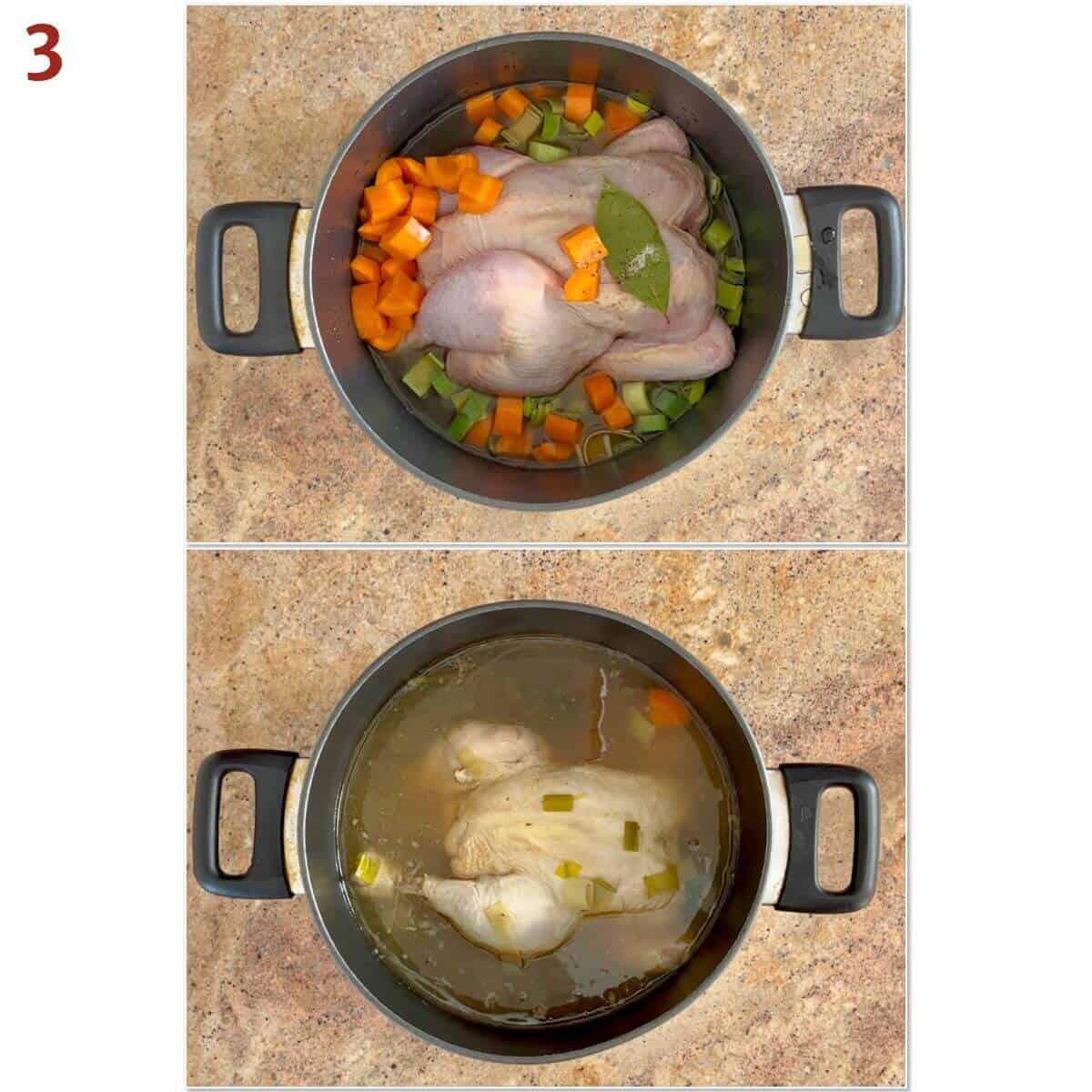
Remove the chicken to a cutting board. Pierce it between the leg and thigh with a skewer to ensure the juices run clear (no trace of pink), or make sure it reads at least 165˚F in the thickest part of the chicken with a digital thermometer (photo 4). Allow the chicken to cool for a few minutes.

Add the pearl barley and prunes to the pot. Bring the soup back to boiling, then reduce the heat to low and simmer for 20 minutes, or until the barley is soft (photo 5). Remove the bay leaf and season the soup with additional salt and pepper to taste.
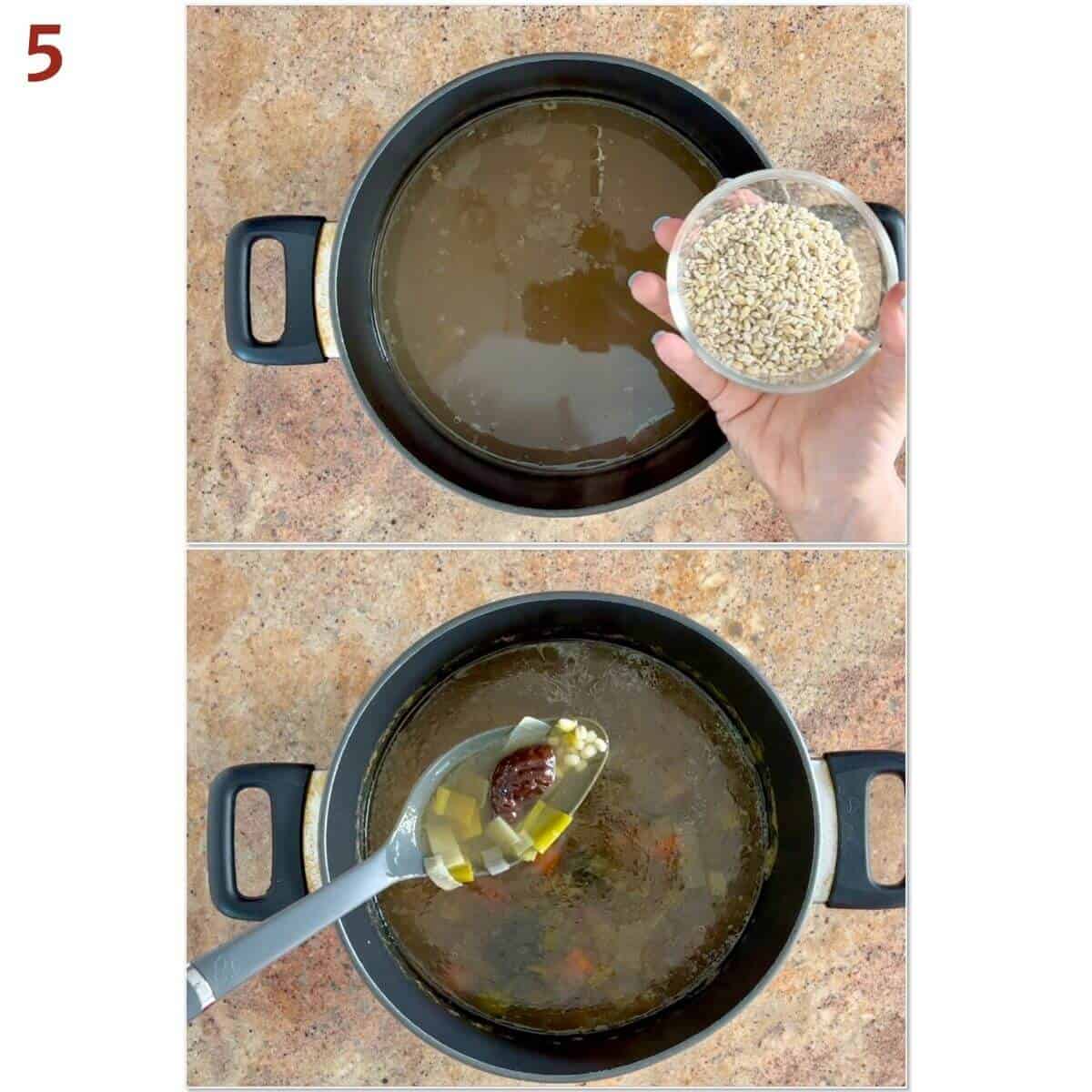
Step 4: Assemble the soup
While the soup is simmering, remove the chicken from the carcass and slice it into bite-sized pieces, discarding the skin and bones (photo 6).

To serve, place about ½ cup of cubed chicken in a soup bowl and ladle the soup and vegetables on top (photo 7). Garnish with parsley and serve.
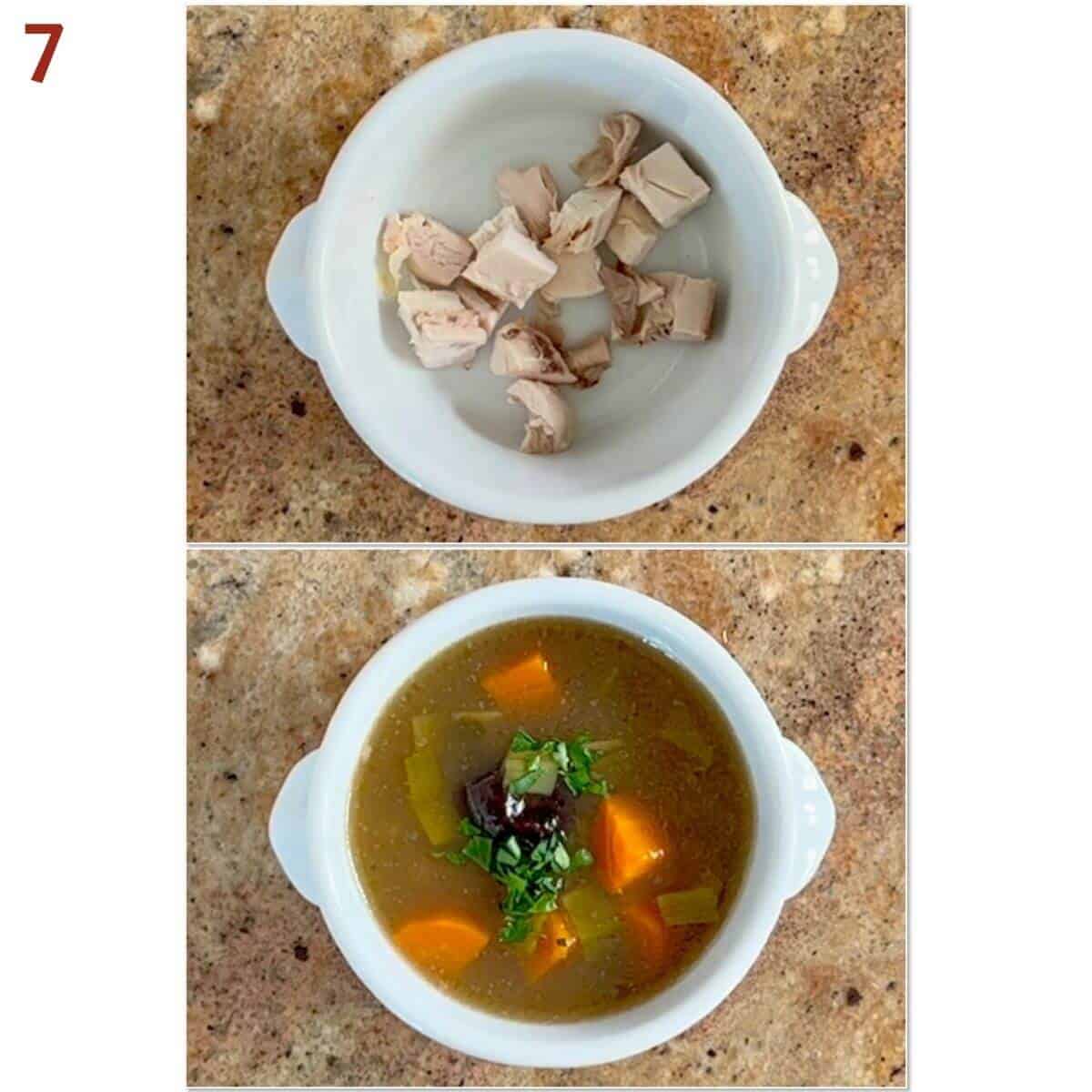
Storage instructions
Storage instructions: If you're not serving the soup right away, cool it safely before refrigerating it. It's important for food safety that the soup not sit out for more than 2 hours, so place it in a large enough bowl sitting in an ice bath (the sink filled with ½ ice and ½ water works well) until it reaches at least 80˚F. Cooled soup can be stored in a sealed container in the refrigerator for up to a week.
For longer storage, freeze in an airtight container, a quart canning jar, or even a ziplock bag, leaving about 1-inch of headroom for expansion, for up to 3 months.
Questions asked and answered
Here are some questions you might have...
Cock-a-Leekie Soup (Chicken and Leek soup) has a long history, dating back to the 16th century. Cooks have made this traditional Scottish soup in many different ways over the years, with the common feature being a chunky soup of chicken, leeks, and whatever vegetables are at hand. It's Scotland's national soup!
Chicken soup has the best flavor when it's made using unsalted chicken stock. Long simmered bone broth made with chicken bones, vegetables (like onions, carrots, and celery), herbs and spices (like parsley, thyme, bay leaves, and peppercorns) creates a golden liquid with a rich mouthfeel.
If you're not serving the soup right away, cool it safely before refrigerating it. It's important for food safety that the soup not sit out for more than 2 hours, so place it in a large enough bowl sitting in an ice bath (the sink filled with ½ ice and ½ water works well) until it reaches at least 80˚F. Cooled soup can be stored in a sealed container in the refrigerator for up to a week.
For longer storage, freeze in an airtight container, a quart canning jar, or even a ziplock bag, leaving about 1-inch of headroom for expansion, for up to 3 months.
You'll find some Cock-a-Leekie Soup recipes that start with the chicken being simmered in water with leeks and carrots. After removing the chicken for slicing, the liquid is strained and the soup is simmered again with more leeks, carrots, prunes, barley, and seasonings. This method is helpful if you don't have chicken stock on hand prior to starting the soup (and have double the vegetables available).

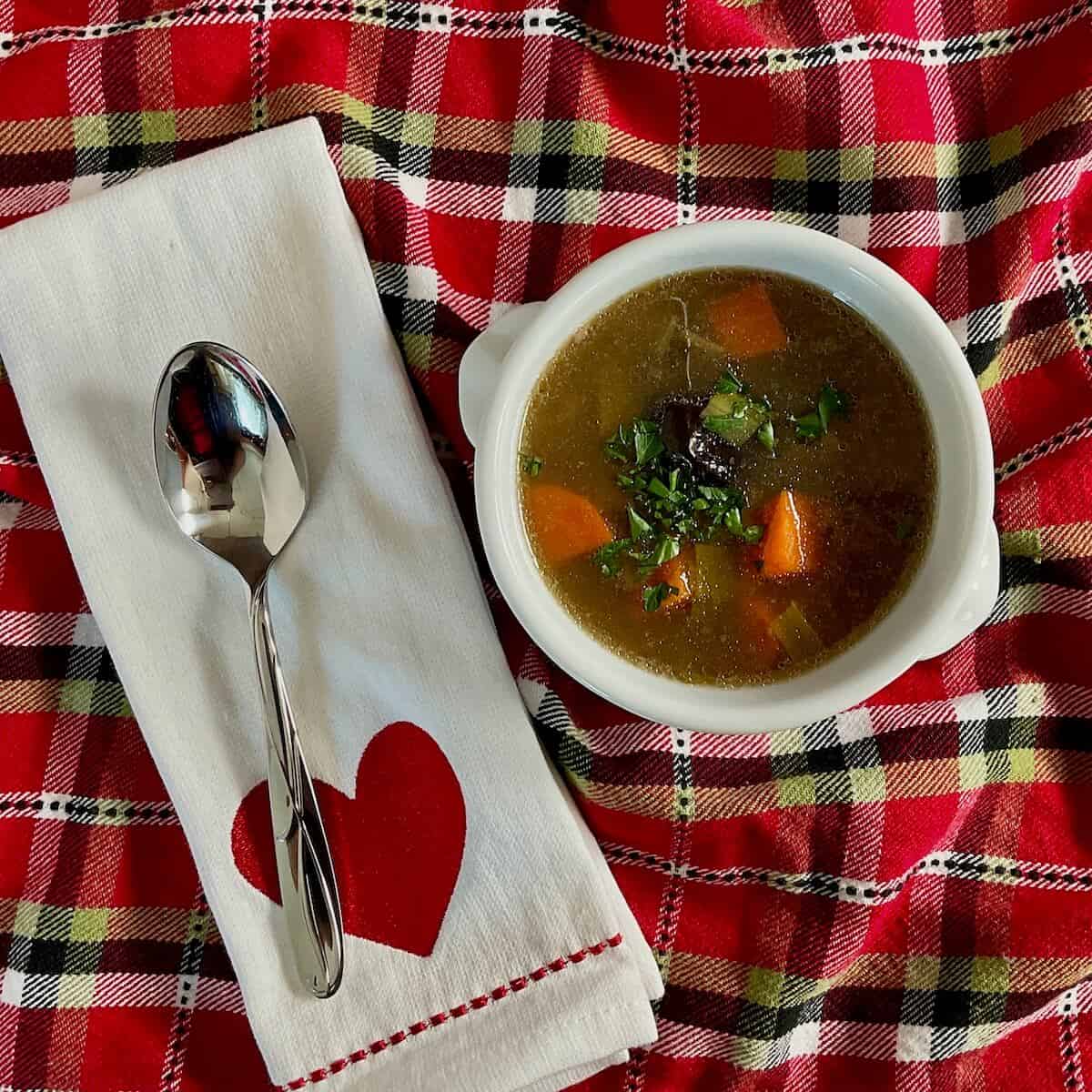
More dinner recipes to try
Recipe

Scottish Cock-a-Leekie Soup
Equipment
- 8-quart stock pot
Ingredients
- 1 chicken, whole, about 3 to 4 pounds, see Recipe Notes
- 1 quart chicken stock, preferably unsalted, or more as needed, see Recipe Notes
- 2 leeks, halved and rinsed
- 1 carrot, large, peeled and halved lengthwise
- 1 bay leaf
- 2 teaspoons kosher salt, or to taste
- ¼ teaspoon black pepper, freshly ground, or to taste
- ½ cup pearl barley
- 6 prunes, halved, see Recipe Notes
- fresh parsley, chopped, for garnish
Instructions
- Use a stock pot that is big enough to fit the chicken snugly.
- Slice off the top green leaves of the leeks (save for making stock, if desired) and split the white stem in half lengthwise. Fan out the layers and rinse them well under cold running water to remove any dirt. Slice the leeks ½-inch thick and place in the stock pot. Top the leeks with the chicken.
- Slice the carrots ½-inch thick, then add them along with the bay leaf, salt, and pepper to the pot. Pour in the stock to cover the chicken, adding additional stock (or just water) if needed.
- Bring the soup to boiling over a high heat. Cover and simmer over low heat for 1 to 1¼ hours, or until the chicken is cooked through.
- Remove the chicken to a cutting board. Pierce it between the leg and thigh with a skewer to ensure the juices run clear (no trace of pink), or make sure it reads at least 165˚F in the thickest part of the chicken with a digital thermometer. Allow the chicken to cool for a few minutes.
- Add the pearl barley and prunes to the pot. Bring the soup back to boiling, then reduce the heat to low and simmer for 20 minutes, or until the barley is soft. Remove the bay leaf and season the soup with additional salt and pepper to taste.
- While the soup is simmering, remove the chicken from the carcass and slice it into bite-sized pieces, discarding the skin and bones.
- To serve, place about ½ cup of cubed chicken in a soup bowl and ladle the soup and vegetables on top. Garnish with parsley and enjoy!
- Storage instructions: If you're not serving the soup right away, cool it safely before refrigerating it. It's important for food safety that the soup not sit out for more than 2 hours, so place it in a large enough bowl sitting in an ice bath (the sink filled with ½ ice and ½ water works well) until it reaches at least 80˚F. Cooled soup can be stored in a sealed container in the refrigerator for up to a week.
- For longer storage, freeze in an airtight container, a quart canning jar, or even a ziplock bag, leaving about 1-inch of headroom for expansion, for up to 3 months.



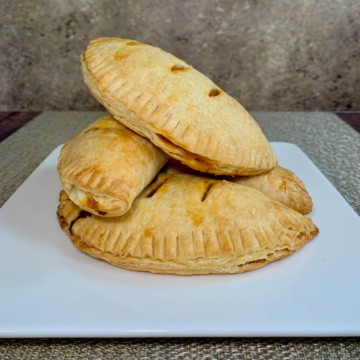




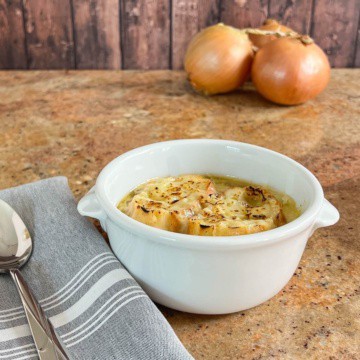


Terrence W Walsh says
Solid recipe, with good ingredient list and reliable directions. Accurate times.
We loved it. The cut-up prunes vanished so as to be invisible, yet they did add a nice sweetness. Nobody guessed they were even in the soup. Carrots serve a similar function; you could use 3 carrots instead of one, if you have no prunes available, to subtly sweeten the soup.
Made it with two partially frozen chicken legs. One hour was enough to cook them to over 190 F, then removed and deboned per recipe.
The soup was fairly thick due to the barley absorbing broth. Beware scorching in last 10 minutes.
I expect to make this again.
Tammy Spencer says
Hi Terrence, I'm glad you liked it! Thanks for sharing 🙂